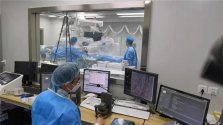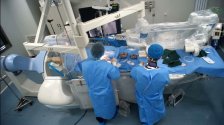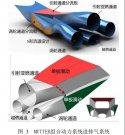I'm not even sure what are potent closed source DBMS today. Oracle? Snowflake?Operating system is a non-issue. Linux and ASOP is available to all
Database is a none-issue as well. Plenty of open-source alternatives and Alibaba and others developed more powerful ones
You are using an out of date browser. It may not display this or other websites correctly.
You should upgrade or use an alternative browser.
You should upgrade or use an alternative browser.
News on China's scientific and technological development.
- Thread starter Quickie
- Start date
examples,
this guys too, they are also in the process of developing e-beam lithography tools according to a patent I read from them.
you know, this is the basic problem of these so called experts, they always been outdated. largely unaware of China's recent development and progress. China also conquered heavy duty gas turbines. E and F fully indigenous. H is in final phase of development.This is outdated. there are at least 3 local scanning electron microscope producers.
Breaking - For the first time in China, an interventional brain-computer interface has been implemented in the sheep brain.
On June 25, the first domestic interventional brain-computer interface independently developed by China successfully completed animal testing in Beijing. The interventional brain-computer interface of this experiment was led by the research team of Duan Feng, a professor at the School of Artificial Intelligence of Nankai University, and jointly developed with Shanghai Xinwei Medical Technology Co., Ltd.
On June 25, the first domestic interventional brain-computer interface independently developed by China successfully completed animal testing in Beijing. The interventional brain-computer interface of this experiment was led by the research team of Duan Feng, a professor at the School of Artificial Intelligence of Nankai University, and jointly developed with Shanghai Xinwei Medical Technology Co., Ltd.
Attachments
It's not even outdated... They just outright don't have the ability to learn this stuff nor the interest. This is because it would otherwise portray China in a 0.1% positive light and they never do that unless forced to by circumstances and then it's but at what cost.you know, this is the basic problem of these so called experts, they always been outdated. largely unaware of China's recent development and progress. China also conquered heavy duty gas turbines. E and F fully indigenous. H is in final phase of development.
Kyky has been making electron microscopes since the 1958. Literal Cold War era state owned enterprise. They had 60+ years to learn about it. They refused to do so. But that is their problem not China's.
C
China only approved gene editing within a species (modifications of its natural genes). Still opposes mixing of genes of different species ( introduction of foreign genes from completely different species).I get what you are saying but bananas are also genitically modified through centuries of selective breeding
Notice the ("fake") banana on the left and the (natural) banana on the right...
View attachment 91112
Humans have been involved in some of form of modifying the genes of crops for thousands of years already. Now if you are specifically opposed to artificial clinical gene modification, that's another matter. Mind you though, even China has backed down from its previous stance on resisting GMOs
News report in Chinese:Breaking - For the first time in China, an interventional brain-computer interface has been implemented in the sheep brain.
On June 25, the first domestic interventional brain-computer interface independently developed by China successfully completed animal testing in Beijing. The interventional brain-computer interface of this experiment was led by the research team of Duan Feng, a professor at the School of Artificial Intelligence of Nankai University, and jointly developed with Shanghai Xinwei Medical Technology Co., Ltd.
传统脑机接口分为侵入式脑机接口和非侵入式脑机接口。侵入式脑机接口需要通过开颅手术或者钻透颅骨将脑电传感器植入脑内,如马斯克的Neuralink脑机接口需要直接从头骨植入,这可能会导致患者大脑的长期炎症。而非侵入脑机接口虽然对人没有伤害,但是脑电信号微弱,识别准确率和实时性受限。
段峰教授科研团队牵头研发的介入式脑机接口技术只需要通过类似心脏搭桥的微创手术便可实现脑机连接。科研团队采用治疗中风的神经介入技术,通过静脉将脑电传感器植入到大脑运动皮层、视觉皮层等脑区后,神经支架膨胀,将电极挤压在靠近大脑的血管壁上,从而获取相应脑区信号。这一技术最大的优点是不需要颅骨钻孔或开颅手术即可获得脑电信号,整个手术植入过程可在两小时内完成。
此次试验的脑电极植入术,由河北工业大学张建华教授科研团队研发的介入机器人辅助完成。该机器人采用主从操作方式,由宣武医院神经外科马永杰主任医师在主端操作,成功完成了部分血管造影。试验最终在羊脑血管内完成了传感器植入,并成功采集到了脑电信号。
据段峰介绍,人体内血管的支架经过长期临床应用及研究,已经拥有较高的安全性。事实上,通过介入式脑机接口这一方式,沿着血管植入传感器,可以连通并激活大脑区域,无需侵入大脑即可获得脑电信息。此次在动物脑内开展的介入式脑机试验研究,在改善人们因脑、脊髓、周围神经或肌肉功能障碍引起的严重瘫痪患者的功能独立性,在治疗癫痫、睡眠障碍、帕金森病等疾病中具有重要意义,未来市场前景广阔。


- Completion of all test flights by 2025 will allow the development of a passenger aircraft that can travel more than 6,000km at Mach 6: researchers
- Challenges for the project include devising a way to slow and land during an emergency as well as commercial viability
The Nanqiang No 1 unmanned aircraft weighs just 500kg (1,100 pounds) but it can reach five times the speed of sound, or faster, according to the team.
The researchers have squeezed into its small body three different types of power systems, a design some experts thought would never work.
The drone can take off and land on a runway like an ordinary plane.
The completion of all test flights by 2025 will pave the way for the development of a full-sized hypersonic aircraft that can transport 10 passengers more than 6,000km (3,700 miles) at Mach 6, according to the research team.
“The breakthrough of this technology will greatly shorten the round-the-world flight time,” lead project scientist Yin Zeyong wrote in a paper published last week in Acta Aeronautica et Astronautica Sinica, a peer-reviewed journal run by the China Society of Aeronautics and Astronautics.
“It can change human civilisation,” said Yin, director of science and technology with the Aero Engine Corporation of China.
Hypersonic flight technology could cut global travel time to anywhere to under two hours, according to Yin’s team.
But the technology and its application has so far remained mostly in the hands of the military. A hypersonic missile, for instance, can hit a high-value target before most missile defence systems can react.
Many countries are engaged in a heated race on hypersonic technology. China, now in a leading position, plans to build a small fleet of manned hypersonic aircraft that can arrive anywhere on the planet within an hour or two by 2035.
Nearly all Chinese hypersonic aircraft programmes remain classified. The paper by Yin and his collaborators at Xiamen University in southeastern Fujian province offered a rare peek into the technical route and progress in this sensitive sector.
Nanqiang No 1 used a state-of-the-art combined cycle engine design known as multi-ducted twin-turbines ejector-ramjet/scramjet, or MUTTER.
The unique power system includes a pair of turbine engines, a small rocket and two air-breathing ramjet or scramjet engines.
This scheme is more complex than most hypersonic flight vehicles proposed before. Some experts opposed the idea because adding the rocket, for instance, could make the aircraft too heavy for a long distance flight.
Yin’s team stuck to the MUTTER design, with a number of innovations to improve flight efficiency, such as forcing three different types of engines to share a single air inlet.
While it had not been done before, computer modelling, ground testing and early test flights suggested the idea worked.
When taking off from a runway, the two turbines could provide a high thrust at speed below Mach 2, according to the researchers. The rocket engine, although relatively small, would accelerate the aircraft to Mach 4. Then the sub-ramjet above and the main-ramjet below the aircraft would ignite and take the plane to a cruising speed at Mach 6.
According to a report by Science and Technology Daily in 2020, during the first stage of the test flights, which started in 2019, Yin’s team kept the plane below the speed of sound.
By the time they wrote the paper, the work had moved to the second stage, pushing the speed to Mach 4, according to the researchers.
The construction of a full-sized passenger plane with a total weight reaching 72 tonnes would likely begin before the end of the six-year programme.
The project faces many technical challenges.
It is not clear whether the small rocket engine can be reused after being put to work in an extreme environment.
A hypersonic airliner would carry 10 adult passengers, making up only about 2 per cent of its weight. But Yin said the technology must be more efficient if it is to be commercially attractive.
The researchers must also devise an effective plan to slow down and land the aircraft quickly in an emergency.
“China wants to use a dozen or two dozen years to complete what others have done in over 100 years,” said Yin, then 73 years old, in an interview with China Youth Daily in 2018.
“We have to make up for lots of missed lessons.”
picture - Air inlet and exhaust of the MUTTER hypersonic engine design that uses three different types of power systems



